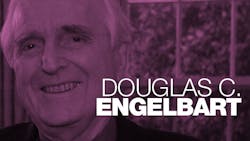For better or worse, your computer and its connections to information and other people worldwide were the vision of Douglas C. Engelbart. It all started as he contemplated his impending marriage while driving to work back in 1951. "I was excited about getting married and starting a family, but then I thought I had better focus on work," he said.
"Suddenly, in my mind, I saw a big, long hallway going on into infinity with here and there doors on the right and windows on the left. What would you think of?" he asked. "What it told me was, 'Oh my golly, I don't have any career goals beyond having a steady job.' That really hit me. I thought I had better start thinking about career goals."
So he went to a library and started to research goals that appealed to him. "I was looking for big goals, goals on how one could contribute the most to mankind. I could clear the swamps where malaria festered or help feed starving people, for example. Then, while hunting through the library, I thought, 'Gosh, it is so complicated, so hard to find things,'" he said.
"Quickly, I realized generalization was the approach I needed to follow," he explained. "There are lots of big problems in the world. If we don't find solutions, it could mean setbacks for humanity. Even extinction."
His thoughts went on to the problem-solving methods used then. "We don't seem to be able collectively to understand complex issues, much less put together plans and manage them. The complexity and urgency of our major problems seemed overwhelming," he said.
"So I thought, 'What could I do to help humanity get better at learning, at developing the ability to perceive and understand the really big, complex problems, and at finding solutions and implementing them?' That is when I said, 'Aha! That would make a really big lifetime goal: Improving our collective capability to cope with large-scale problems,'" he explained.
Out of that goal came the personal-computer workstation, now as ubiquitous as pen and paper. Prior to Engelbart's visions, computers were big machines with racks of electronic tubes used primarily for crunching numbers. They've come a long way in form, power, and purpose since then.
From Radar to Vannevar Bush
Engelbart's Navy experience as a radar technician, along with his discovery of Vannevar Bush's 1945 article "As We May Think" on the use of machines as mechanical aids, many years later led him to his concept of a display screen for text, pictures, word processing, and display editing - basically, today's graphical user interfaces.
He strongly believed "windows" of information should open when users touched hyper-linked text for further information so they could drill deeper and deeper for data. Those hyperlinked text items would be touched through another device he invented - the computer mouse. This machine then would be used for sharing information with others on similar machines to augment human knowledge to solve significant problems.
So, Engelbart headed to the University of California at Berkeley to be part of a program to develop a general-purpose digital computer - not just one for doing mathematical calculations.
Too Early but Persistent
Despite his half-dozen patents in "bi-stable gaseous plasma digital devices," his colleagues at Berkeley considered his ideas so unrealistic that he didn't think advances were likely. Computers were seen as tools for calculations or for helping secretaries, not for intellectuals to use to address issues. On top of that, most computer work was being done, not in California, but on the East Coast at places like the Massachusetts Institute of Technology. Getting funds for an area of the country not then known for its computer expertise wasn't easy.
Still, Engelbart persisted in following his vision. "I was naive and dedicated. That was really a problem. I actually got ridiculed quite often," he said. "We have to realize, there are things like paradigms. They are just very, very important social phenomena. It's the way people get a collective feeling. And it's very hard to change. Some people feel like it is cutting off your feet to go against prevailing paradigms."
When people around him no longer supported his ideas, Engelbart moved on, but kept working on his vision. But what about young engineers facing similar ridicule or discouragement?
"The world needs exploration of all kinds," he said. "So it just wouldn't be good to discourage people from trying new things. Tell them you could be getting mired down in swamps if you are searching for something new, but that is the only way civilization's frontiers are going to be explored."
Still Searching for Solutions
Despite his 82 years, Engelbart is still working on ways to make it easier to resolve complex issues and augment how mankind works. For instance, he believes the future could bring methods for the computer to understand and analyze a document's syntax. It then could be used to indicate the point in a text, say, about global warming, where a conflict started. And, it could present the counterarguments. "You could graphically show a structured argument with all kinds of rationale," he said.
"Lately, I've been enjoying being engaged with younger generations at places like Berkeley, Google, and MIT to talk about how our collective IQ augmentation idea can really take off. It's worth exploring," he said.
"There is still a frontier to explore. I enjoy discussing the big frontier in this augmenting thing, different ways of using our brains, putting together sentences and plans," he said. "I'm really sure that if we look at it together, we can boost our capabilities."
